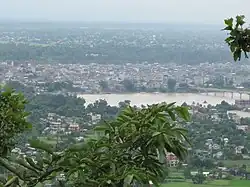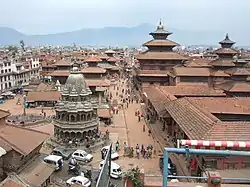.svg.png.webp) |
|---|
|
|
The administrative divisions of Nepal (Nepali: नेपालको प्रशासनिक विभाजन, romanized: Nēpālakō praśāsanik vibhājana) are subnational administrative units of Nepal. The first level of country subdivision of Nepal are the provinces. Each province is further subdivided into districts, each district into municipalities and rural municipalities, and each of those municipalities into wards. Before 2015, instead of provinces, Nepal was divided into developmental regions and administrative zones.
Fulfilling the requirement of the new constitution of Nepal in 2015, all old municipalities and villages (which were more than 3900 in number) were restructured into 753 new municipalities and rural municipalities.[1][2] The former 75 district development committees (DDC) were also replaced by 77 new district coordination committees (DCC) which have much less power than the DDCs. At present there are 6 metropolitan cities, 11 sub-metropolitan cities, 276 municipalities, and 460 rural municipalities.
| Federal Government | |||||||||||||||||||||||||||||||||||
| 7 Provinces (e.g. Gandaki) | |||||||||||||||||||||||||||||||||||
| 77 Districts (e.g. Parbat) | |||||||||||||||||||||||||||||||||||
| 6 Metro Cities (e.g. Kathmandu) | 11 Sub-Metro Cities (e.g. Dharan) | 276 Municipalities (e.g. Lamki Chuha) | 460 Rural Municipalities (e.g. Mahashila) | ||||||||||||||||||||||||||||||||
Provinces

Nepal is composed of seven provinces.[3] They are defined by schedule 4 of the new constitution, by grouping together the existing districts. Two districts however are split in two parts, ending up in two different provinces.
| Province | Capital | Governor | Chief Minister | Districts | Area | Pop. (2021) |
Density (/km2) |
HDI (2019) |
GDP per capita (USD; 2021) | Map |
|---|---|---|---|---|---|---|---|---|---|---|
| Koshi Province | Biratnagar | Parshuram Khapung | Hikmat Kumar Karki | 14 | 25,905 km2 | 4,972,021 | 192 | 0.597 | 1,298 |  |
| Madhesh Province | Janakpur | Hari Shankar Mishra | Saroj Kumar Yadav | 8 | 9,661 km2 | 6,126,288 | 767 | 0.538 | 882 |  |
| Bagmati Province | Hetauda | Yadav Chandra Sharma | Salikram jamarkattel | 13 | 20,300 km2 | 6,084,042 | 300 | 0.673 | 2,640 |  |
| Gandaki Province | Pokhara | Prithvi Man Gurung | Khagraj Adhikari | 11 | 21,504 km2 | 2,479,745 | 116 | 0.631 | 1,348 |  |
| Lumbini Province | Deukhuri | Amik Sherchan | Lila Giri | 12 | 22,288 km2 | 5,124,225 | 230 | 0.583 | 1,209 |  |
| Karnali Province | Birendranagar | Tilak Pariyar | Raj Kumar Sharma | 10 | 27,984 km2 | 1,694,889 | 61 | 0.568 | 1043 |  |
| Sudurpashchim Province | Godawari | Ganga Prasad Yadav | Rajendra Singh Rawal | 9 | 19,915 km2 | 2,711,270 | 136 | 0.579 | 1135 |  |
| Nepal | Kathmandu | President Bidya Devi Bhandari |
Puspa Kamal Dahal ‘Prachanda’ | 77 | 147,641 km2 | 30,192,480 | 198 | 0.602 | 1,372 |  |
Districts

Provinces are further divided into districts, of which there are 77 (as of 2017).[4] Each of the districts is governed by a District Coordination Committee.
Municipalities of Nepal
Urban municipalities
Municipalities are places having at least some minimum criteria of population and infrastructure and declared as a municipality by the government. There are 293 municipalities in Nepal.
Urban municipalities are categorized into 3 levels:
- Metropolitan city (Mahanagarpalika)
- Sub metropolitan city (Upmahanagarpalika)
- Municipality (Nagarpalikas)
There are six metropolitan cities; the capital city Kathmandu, as well as Bharatpur, Biratnagar, Pokhara, Lalitpur and Birgunj. There are 11 sub-metropolitan cities and 276 municipalities.
| Rank | Name | Province | Pop. | Rank | Name | Province | Pop. | ||
|---|---|---|---|---|---|---|---|---|---|
 Kathmandu  Pokhara |
1 | Kathmandu | Bagmati | 845,767 | 11 | Janakpur | Madhesh | 195,438 |  Bharatpur  Lalitpur |
| 2 | Pokhara | Gandaki | 518,452 | 12 | Butwal | Lumbini | 195,054 | ||
| 3 | Bharatpur | Bagmati | 369,377 | 13 | Tulsipur | Lumbini | 180,734 | ||
| 4 | Lalitpur | Bagmati | 299,843 | 14 | Budhanilkantha | Bagmati | 179,688 | ||
| 5 | Birgunj | Madhesh | 268,273 | 15 | Dharan | Koshi | 173,096 | ||
| 6 | Biratnagar | Koshi | 244,750 | 16 | Nepalgunj | Lumbini | 166,258 | ||
| 7 | Dhangadhi | Sudurpashchim | 204,788 | 17 | Birendranagar | Karnali | 154,886 | ||
| 8 | Ghorahi | Lumbini | 201,079 | 18 | Tarakeshwar | Bagmati | 151,508 | ||
| 9 | Itahari | Koshi | 198,098 | 19 | Gokarneshwar | Bagmati | 151,200 | ||
| 10 | Hetauda | Bagmati | 195,951 | 20 | Tilottama | Lumbini | 149,657 | ||
Rural municipalities
Rural municipalities (Gaunpalikas) were established in 2017, replacing the village development committees (VDCs). The main purpose of a gaunpalika resembles that of a VDC, but it has more rights on collection of royalty and taxes and has a higher annual budget than the VDC. Several VDCs were usually combined into each new gaupalika. There are 460 gaunpalikas in Nepal.
See also
Notes
References
- ↑ "New local level structure comes into effect from today". www.thehimalayantimes.com. The Himalayan Times. 10 March 2017. Retrieved 17 July 2018.
- ↑ "Govt prepares to add 9 more local levels in Province 2". www.kathmandupost.ekantipur.com. Kantipur Publication. 11 August 2017. Archived from the original on 11 August 2017. Retrieved 15 August 2018.
- ↑ "Nepal divided by new constitution - Foreign Policy News". foreignpolicynews.org. Retrieved 2018-04-07.
- ↑ "There will be 77 districts in the country: Minister Thapa". My Republica. Retrieved 2018-04-07.
- ↑ https://web.archive.org/web/20220206104652/https://cbs.gov.np/wp-content/upLoads/2022/01/Final%20Preliminary%20Report%20of%20Census%202021%20Newfinal.pdf